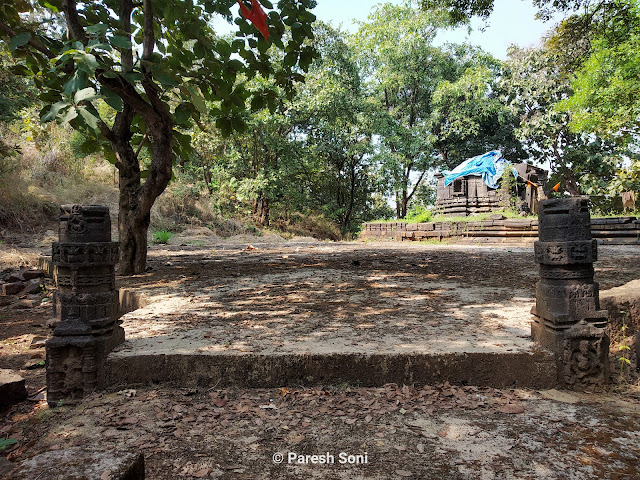Ruins of an ancient Shiva (Pandav) temple in Atgaon below Kasara Ghat
When we talk about an ancient Shiva temple in Mumbai then the first thought reaches to Ambreshwar Shiva temple of Ambarnath which is one of the most beautiful 11th-century temple around Mumbai. But not many are aware of yet another Shiva temple in Atgaon valley which though lies in a very dilapidated state could have been yet another very beautiful temple in its heydays, remnants of the temple prove the point. The Shiva temple as per some information available in the Thane gazetteer shows that it was built in the 12th or 13th century. The temple is well known as Pandav temple.
Having seen some posts about the temple visited by heritage enthusiasts on social media and the fact that there were some hero stones lying in the vicinity evinced my interest in this ancient site. The temple stands some 1.2 km southwest of the Atgaon station on a small hill and the path that crisscrosses the rice fields and the teak forest at the mouth of Atgaon valley. The setting of the temple is such that it cannot be seen from the flat ground and one has to reach the exact spot in between two knolls surrounded by some 9 meters high teak wood spur, to get the first glimpse. The temple in a very crumbling state stands on a high jagati (platform) and seems to be built in an early Hindu style. Remnants of the temple are scattered around the area.
There are two routes to go to the temple, one is from Atgaon station west, take the road going towards Podar Navjeevan complex, on the right-hand side there is a Mahadev temple, take a left turn from the temple towards the rice fields and move towards a small hill. Another route is from Mumbai - Agra highway from Pundhe village.
After crossing Shahapur, there is a railway crossing for Pundhe village. The second left after the crossing takes one to Pundhe village. Take a right after entering the village towards the crematorium and enter the rice fields from a small temple. There is a waterfall route that will directly take you to the steps of the temple.
As one reaches the steps, remnants of the temple structure can be seen scattered around, which includes main temple remnants as well as broken hero stones.
Two small half-broken pillars on either side welcome you as you reach the temple complex. There is ornamental design carved on the pillars with one of them having an idol of Lord Ganesha carved at the bottom while the figuring on the other pillar seems to have eroded completely.
In the middle of the cleared area stands a jagati or a platform made from basalt rock and on which stands the temple in a very crumbling state.
There are few steps visible on the jagati which indicates that it could have been the entrance to the larger temple complex. A kichak stone and two broken hero stones lay near the steps. The hero stone here shows a fight between the enemy and the warrior in one of the panels.
In the middle of jagati(platform) lies the main temple in a very broken state yet the main sanctum and the entrance seem to be intact.
One more hero stone stands at the side of the entrance. The uniqueness of the hero stone is the lower panel shows the couple in a dead position indicating that probably the women committed sati or died alongside the husband defending/fighting.
The entrance to the temple is intricately carved with some figures of deity and in the sanctum lies a Shiva linga as well two more idols covered in orange vermillion and draped in saree-like attire.
On the other side of the temple which takes one to the Atgaon route, there are similar pillar structures in a completely broken state. An indication that the temple probably had two entrances. Two four-faced hero stone stands in the temple compound, one of which has a panel showing the warrior died protecting the cattle wealth. Another hero stone in the compound has a lower panel has a saint in a meditation state with a beautiful lady on each side comforting him. These could be samadhi hero stone of some saint.
With so many hero stones around in the temple complex indicating that the location of the temple is very close to the Kasara ghat area which connects with Nasik / Igatpuri region and was an ancient trade route, the situation in the region would have been terrible at times in the contemporary period.
Given the carvings and intricate design on the basalt rock, a jagati and broken pillars on both sides of the temple indicate that temple would have been nothing less than gorgeous in its heydays probably in the 12th and 13th centuries when it was built. The forest surrounding the temple and its location on a small hill gives an aura of peace and tranquility around. Hope ASI or any other government department urgently looks into the condition of the temple and hero stones lying around and initiate restoration which will prevent further erosion and loosing of valuable heritage & history of our city and state.































Comments
Post a Comment